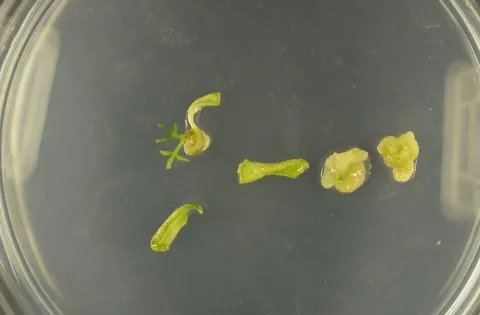The common ash (Fraxinus excelsior L.) is a temperate tree species with a wide distribution across Europe. It is also found in Asia Minor and Africa and from the Arctic Circle to Turkey. Of the four different ash species growing naturally, common ash is the most important commercially. The properties of high-quality timber such as elasticity, hardness, and impact resistance make it is used widely in many different industries. It is mainly used for tool holders and sports equipment, e.g. hockey sticks or oars. Its straight grains make it widely used in carpentry for the production of stairs, handrails, doors, windows, and veneers.
The common ash is also an excellent material for parquet. Due to calorific value, it is used as fuelwood. In central Europe, it has been used as an ornamental tree in parks and along roads and city streets. Ash is one of the most common trees in the United Kingdom. In many countries, it has some ethnic and cultural significance. There is also a very long tradition of using common ash as a source of natural healing substances. For example, substances in the root and leaves have a diuretic effect and help with gout and kidney stones. The bark and leaves extracts are used in the treatment of rheumatic diseases such as rheumatoid arthritis. This plant also has cosmetic properties. In the northern and western parts of its range, common ash grows in lowland forests, while further South and West it increasingly grows in mountainous areas. It is an important component of several natural habitats.

Diseases and means of protection
Since the mid-1990 in European countries, we have observed dieback of this species, causing the death of over 90% of all ash trees in several countries. The ash common dieback is observed in Norway, Denmark, Lithuania, Austria, Belgium, the Czech Republic, Finland, France, Germany, Hungary, Italy, the Netherlands, Slovenia, Sweden, Estonia, Latvia, Switzerland, and Great Britain. The dieback is caused by the ascomycete Hymenoscyphus fraxineus. This phenomenon threatening the existence of F. excelsior over our continent. A wide range and variety of purposes of common ash wood cause that dieback of this species is an enormous problem, not only ecological but also economic.
Given the above, solutions for renewal and preservation should be developed. It is even more important because the observed dying of common ash already results in very clear problems in obtaining seeds. To make matters worse the seeds are often poor quality and have low germination, which makes it very difficult to obtain new specimens of ash. One way to protect and regenerate common ash is to obtain seedlings in vitro.
Currently, the method of somatic embryogenesis can be used for this purpose. In this method, the embryogenic callus is inducted with somatic embryos at all stages of embryo development, i.e., globular, heart, torpedo, and cotyledonous stages. Ultimately, the somatic embryo can be used to regenerate the entire plant. However, the method of somatic embryogenesis is characterized by the high cost and commonly observed genetic instability of callus cells. Therefore, the development of a new, more effective method is desirable.
The solution of scientists from Krakow in Poland
The scientists from the Krakow Universities came up to fulfill these expectations. The interdisciplinary research team, composed of dr hab. inż. Katarzyna Nawrot-Chorabik, prof. UR from the Faculty of Forestry of the University of Agriculture in Krakow and dr hab. Dariusz Latowski from the Faculty of Biochemistry, Biophysics, and Biotechnology of Jagiellonian University has developed a technology for obtaining common ash seedlings by indirect adventitious organogenesis.
This method omits the stage of forming and development of the somatic embryo, and thus significantly reduces the number of passages and expensive components of culture media. Plant regeneration occurs directly from callus tissue, which results not only in lower costs of seedling production but also, what is very important, improved genetic stability compared with micro-propagation by the method of somatic embryogenesis.
Besides, the developed method allows obtaining calluses with selected genotypes, e.g. resistance to negative abiotic or biotic factors (including pathogenic fungi). The obtained seedlings have genotypes identical to the callus genotype and therefore are also resistant to harmful biotic and abiotic environmental conditions. This can significantly improve the condition of stands with common ash, positively affecting the ecological and economic aspects related to this species of tree.
Advantages of the technology:
- obtaining genetically stable cuttings;
- obtaining seedlings with selected genotypes, e.g. pathogen-resistant;
- simpler and less time-consuming method compared to currently used methods;
- lower costs of obtaining seedlings compared to currently used methods
Innovation is the subject of the patent application. Further research on technology development is carried out at the Faculty of Biochemistry, Biophysics, and Biotechnology of Jagiellonian University and Faculty of Forestry of the University of Agriculture in Krakow.
Centre for Technology Transfer CITTRU from Jagiellonian University is looking for entities interested in cooperation in implementing the invention.
For detailed information please contact:
Renata Bartoszewicz, Ph.D.
Technology Transfer Officer
Centre for Technology Transfer CITTRU
Jagiellonian University
Phone: +48 12 664 42 08, 515 493 518
e-mail: renata.bartoszewicz@uj.edu.pl
